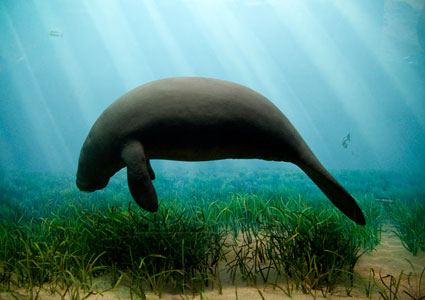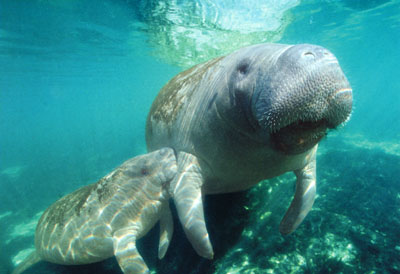
March 17, 2008

Various interviews I’ve had with St. Johns River and Lake Monroe area residents who remember the news reports from the 1950s still do feel that the reports were merely “Northern” tourists who saw unusual (but known) animals in the local waters. The number one candidate: manatee.

Manatees generally do stay below the surface, but have to come up for air, of course. Reflective of the lower population density in the 1950s, they may have been a rather surprising sight.
Some manatees do, also, have light gray to pinkish looking skin, in various light or water conditions.

There are five species of Sirenia, but scientists believe that there were many more in the past. Early forms of manatees are thought to have originated near the Amazon basin in South America. Some remained there to become the Amazonian manatee (Trichechus inunguis), while others migrated up through the Caribbean, giving rise to the Antillean (Trichechus manatus manatus) and Florida manatees (Trichechus manatus latirostris). Another group managed to swim or were carried on currents across the Atlantic and became the West African manatee (Trichechus senegalensis).
Dugongs, known by the scientific name as Dugong dugong, are thought to have evolved along with manatees, and they once ranged from Europe to Africa, and along the east and west coasts of the Americas. At the present time, they are found only in the Eastern Hemisphere in the Indian and Pacific Oceans.
Steller’s sea cow (Hydrodamalis gigas), another species of Sirenia, [allegedly] became extinct in the 1700s. ~ Source.

Does part of the answer to Lake Monroe Monster, at least, rest with the manatee?
Go observe for yourself.
One of the best places to see manatees up close is Blue Springs State Park in Orange City, Florida. I highly recommend it.

About Loren Coleman
Loren Coleman is one of the world’s leading cryptozoologists, some say “the” leading living cryptozoologist. Certainly, he is acknowledged as the current living American researcher and writer who has most popularized cryptozoology in the late 20th and early 21st centuries.
Starting his fieldwork and investigations in 1960, after traveling and trekking extensively in pursuit of cryptozoological mysteries, Coleman began writing to share his experiences in 1969. An honorary member of Ivan T. Sanderson’s Society for the Investigation of the Unexplained in the 1970s, Coleman has been bestowed with similar honorary memberships of the North Idaho College Cryptozoology Club in 1983, and in subsequent years, that of the British Columbia Scientific Cryptozoology Club, CryptoSafari International, and other international organizations. He was also a Life Member and Benefactor of the International Society of Cryptozoology (now-defunct).
Loren Coleman’s daily blog, as a member of the Cryptomundo Team, served as an ongoing avenue of communication for the ever-growing body of cryptozoo news from 2005 through 2013. He returned as an infrequent contributor beginning Halloween week of 2015.
Coleman is the founder in 2003, and current director of the International Cryptozoology Museum in Portland, Maine.
Filed under Breaking News, Cryptomundo Exclusive, Cryptotourism, CryptoZoo News, Cryptozoologists, Cryptozoology, Expedition Reports, Eyewitness Accounts, Lake Monsters, Living Dinosaurs, Mokele-Mbembe